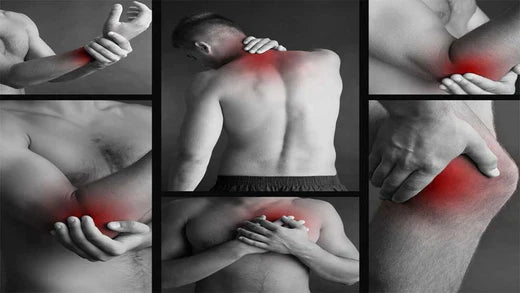Les étirements préviennent-ils les blessures ?

Étirements pour la prévention des blessures :
Les étirements consistent à manipuler le mouvement d'un muscle dans le but de l'allonger. Vous constaterez ainsi plusieurs bienfaits, notamment une plus grande souplesse. Mais les étirements peuvent-ils prévenir les blessures ?
Examinons ce que disent les études sur les étirements, leurs avantages et si les étirements sont un outil utile pour la prévention des blessures.
Types d'étirements
Il existe cinq types d'étirements courants. Nous les classons du plus facile au plus complexe.
Étirements passifs : Comme leur nom l'indique, les étirements passifs consistent à positionner le corps dans une position où un groupe musculaire peut être étiré sans force ni pression supplémentaire. Se pencher pour toucher ses orteils en est un excellent exemple.
Étirements statiques : On utilise souvent à tort l'étirement statique et l'étirement passif de manière interchangeable. Bien que les deux formes nécessitent de rester en position d'étirement pendant une durée déterminée, c'est lors des étirements statiques que l'on applique activement une pression ou une force supplémentaire pour prolonger l'étirement. L'étirement de la paroi thoracique en est un exemple.
Un tapis abdominal sera votre meilleur ami lors des étirements statiques au sol.
Étirements dynamiques : Également appelés étirements actifs, ces étirements se concentrent sur des mouvements légers, similaires à ceux que vous effectuerez pendant votre entraînement. Par exemple, si vous travaillez vos jambes et que vous faites des squats, vous pouvez effectuer des demi-squats au poids du corps comme étirements dynamiques.
Étirements PNF : Un type d'étirement avancé, la technique derrière l'étirement PNF consiste à se détendre, à se contracter, puis à passer à un étirement plus profond.
Étirements balistiques : Forme d'étirement controversée, l'étirement balistique consiste à « rebondir » sur le tissu conjonctif. L'idée est de dépasser le point de réflexe d'étirement (lorsque le corps force le muscle à se remettre en place) et d'obtenir un étirement plus profond. Il est déconseillé aux débutants ou aux personnes ayant déjà eu des problèmes articulaires.
Avantages des étirements
Avant de répondre à la question de savoir si les étirements préviennent les blessures, examinons les avantages des étirements qui ont été prouvés.
Flexibilité accrue : L’objectif principal des étirements est d’améliorer la souplesse. De nombreuses études ont confirmé que des étirements réguliers peuvent améliorer significativement la souplesse. [1]
Amélioration de l'amplitude de mouvement : Des muscles tendus et des antécédents de blessures ou d'interventions chirurgicales peuvent limiter votre amplitude de mouvement. Adopter une routine d'étirements statiques et dynamiques peut améliorer efficacement votre amplitude de mouvement, permettant ainsi une meilleure mobilité et de meilleures performances globales. [2]
Réduit les courbatures : Les étirements ne peuvent pas éliminer complètement les courbatures d'apparition retardée, mais ils peuvent faire une différence notable. Des études suggèrent que les étirements post-entraînement peuvent contribuer à réduire les courbatures. [3]
Les étirements préviennent-ils les blessures ?
Bien que les étirements soient une activité très bénéfique, ils font l’objet d’un débat acharné quant à leur capacité à prévenir les blessures.
Les conclusions de nombreuses études sont mitigées. Les rapports anecdotiques peuvent varier considérablement. L'argument contre les étirements avant l'entraînement est lié au fait qu'ils pourraient réduire les performances. [4]
Nous préférons la prudence. Que représente une baisse médiocre des performances à l'entraînement – et non en compétition – pour la possibilité de sauver sa peau ?
Nous ne vous disons pas qu'il est nécessaire de faire une séance complète de yoga avant une séance de musculation. En programmant certains types d'étirements, vous minimiserez la baisse de performance et maximiserez leurs bienfaits.
Quand faut-il s’étirer ?
Adapter le type d’étirement au moment approprié – avant ou après l’entraînement – est la clé pour maximiser les avantages des étirements.
Pré-entraînement : étirements dynamiques
Des étirements dynamiques sont recommandés avant votre séance d'entraînement. Commencez par un échauffement de base, comme la marche sur tapis roulant ou l'utilisation d'un stepper.
Après cinq à dix minutes, commencez votre séance d'étirements dynamiques, qui consistera en une version allégée des exercices que vous effectuerez lors de votre entraînement. Quelques exemples :
- Si vous effectuez des squats arrière avec haltères, utilisez des demi-squats au poids du corps comme étirement dynamique.
- Vous faites du développé couché avec haltères ? Faites des pompes contre le mur.
- Vous faites du rowing avec une barre ? Utilisez un tirage latéral léger.
- Vous faites du soulevé de terre ? Utilisez des ponts de poids corporel.
Post-entraînement : étirements statiques
Les étirements statiques sont idéaux après votre séance d'entraînement. Vous pouvez ainsi maintenir les étirements pendant plus d'une minute sans craindre de réduire vos performances.
Nous vous recommandons de faire précéder vos étirements statiques d'un temps de récupération pour garantir que les relations longueur-tension sont réinitialisées et que le sang ne s'accumule pas dans les muscles.
Utilisez-vous des étirements pour prévenir les blessures ?
Pensez-vous que les étirements vous ont aidé à éviter les blessures pendant vos entraînements ? Êtes-vous du genre à les éviter ? Dites-nous ce que vous en pensez sur Facebook .
Références
- de Weijer VC, Gorniak GC, Shamus E. Effet des étirements statiques et des exercices d'échauffement sur la longueur des ischio-jambiers sur 24 heures. J Orthop Sports Phys Ther . 2003;33(12):727-733. doi:10.2519/jospt.2003.33.12.727
- Harvey L, Herbert R, Crosbie J. Les étirements induisent-ils une augmentation durable de l'amplitude articulaire ? Une revue systématique. 2002. Dans : Database of Abstracts of Reviews of Effects (DARE) : Quality-assessed Reviews [Internet]. York (Royaume-Uni) : Centre for Reviews and Dissemination (Royaume-Uni) ; 1995-.
- Andersen JC. Étirements avant et après l'exercice : effet sur les courbatures et le risque de blessure. J Athl Train . 2005 ; 40(3) : 218-220.
- Witvrouw E, Mahieu N, Danneels L, McNair P. Étirements et prévention des blessures : une relation obscure. Sports Med . 2004;34(7):443-449. doi:10.2165/00007256-200434070-00003.

